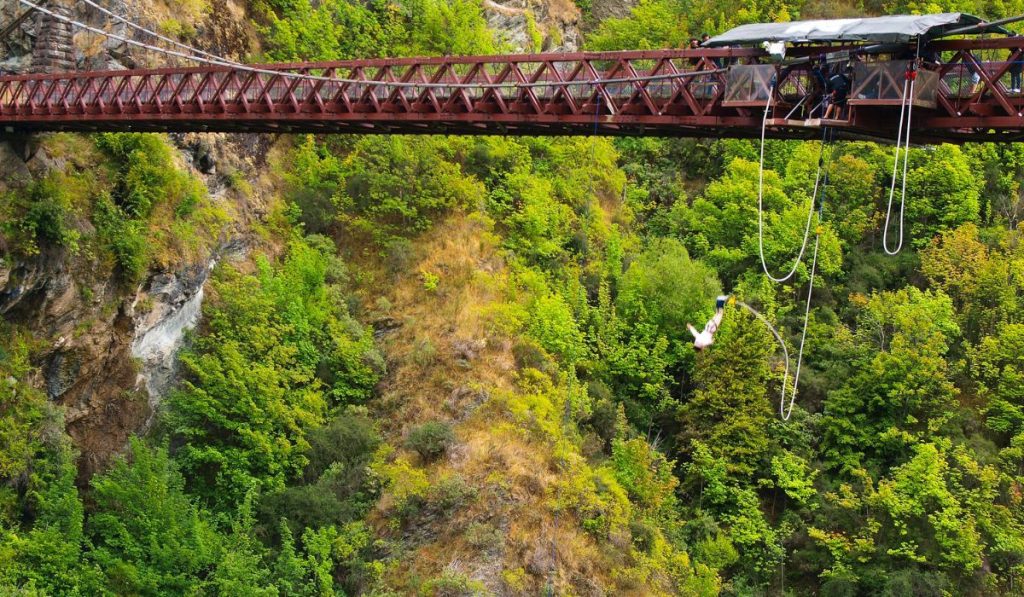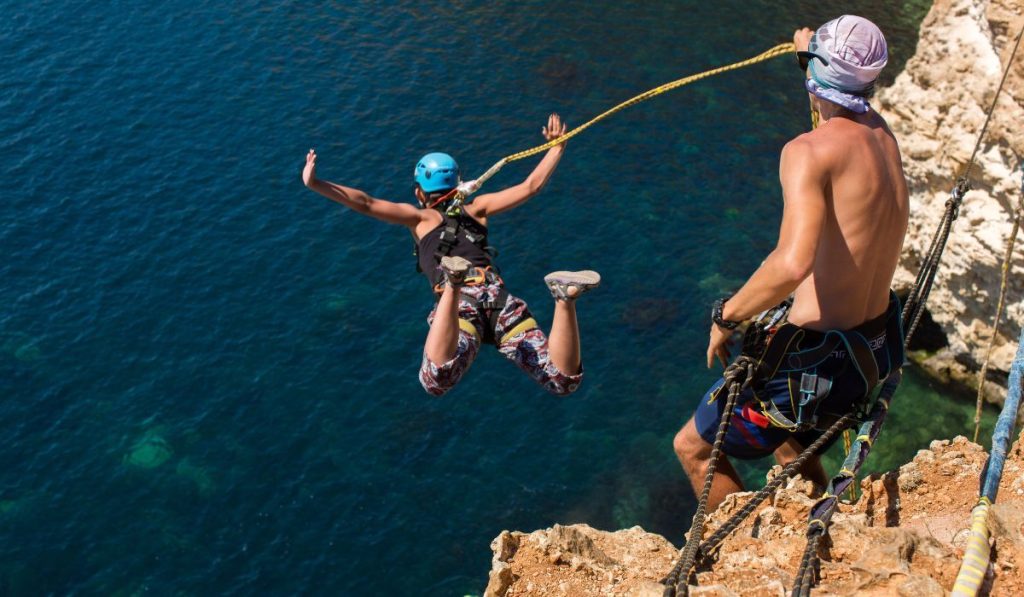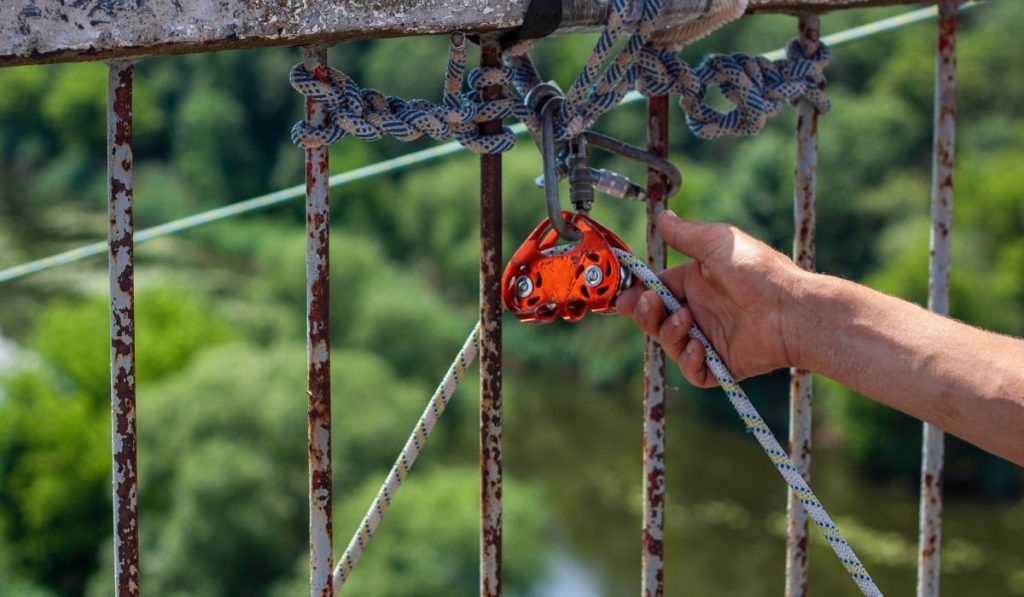As far as adventure sports go, dndoubtedly one to try. The thrill of free-falling from heights gives an adrenaline kick that’s full of fun and excitement.
If you’re thinking about experiencing the thrill for yourself, we’ve prepared a comprehensive guide to all things bungee jumping.
Let’s get to it.
Bungee jumping explained
Bungee jumping is all about leaping from a very high position. You can jump off a tall cliff, tower, crane, or bridge.
You can even jump from a moving object like a hot air balloon if you are out for a thrill.
You’ll have a thick elastic cord tied to your feet or ankles, which recoils almost as instantly as you start your freefall.
As you hurtle from the height, the cord tied to your feet will stretch, then rebound, taking you upwards as it recoils.
After which, you will begin to fall back down.
Picture it like an air trampoline— you’ll bounce up and down a couple of times until the cord loses momentum. How’s that for exhilaration?
Where did it all come from?
There are quite a few tales told about how it all started. Some say a woman tied her feet with a rope in a domestic dispute and jumped off a cliff.
Others say men jumped off cliffs to show off their bravado.
Notwithstanding the stories told, records show that the first known modern encounters with bungee jumping were in the 1970s from Bristol’s Clifton’s bridge.
Eventually, it made its way into the mainstream, with the first bungee jumping location operating commercially in New Zealand in 1989.
Take a look at some of the best places in the USA to bungee jump today!

Is bungee jumping safe?
While falling so far down with nothing but a rope to hold your legs may seem scary, bungee jumping is known to be quite safe.
Establishments are required to stick to a code of safety. You can get a license for it if you don’t meet the standards.
Plus, all the equipment used has to comply with safety standards.
Statistics also show that the risk of dying in a bungee jumping accident is 1 in 500 000.
This means jumps are accident-free most of the time.
Who can bungee jump?
There are usually no limits to bungee jumping; people of all ages can do it.
However, some places will put certain age limits.
But, if you have pre-existing injuries, then you aren’t allowed to jump.
Also, people with conditions like heart problems, high blood pressure, and being overweight can’t jump.
If you’re pregnant, you’re also not allowed to take the leap.
The great feelings from bungee jumping come from the burst of adrenaline release in your body.
That adrenaline released courses through your whole body.
As it makes its way through the body, your heart rate shoots through the roof.
Plus, your metabolic rate and the sugar level in your blood both go sky-high.
So if you have conditions like heart problems or high blood pressure, it would be unsafe for you to try bungee jumping.
That said, if you have a perfect bill of health, there’s nothing to stop you from doing it.
Why do you need to bungee jump?
Agreed, bungee jumping is not for the faint-hearted. It’s an extreme sport.
However, life is all about experiences, and what better way to enjoy a well-lived life than by experiencing something as exhilarating as a bungee jump?
For the thrill-seekers, you simply must take a jump in your lifetime.
Consider adding this adventure activity to your bucket list.

If you want to conquer your fears, especially if you’re afraid of heights, going for a bungee jump will be a great way to conquer your fears.
You can do it gradually, start with heights that are not too daunting for you, and eventually work your way up to taking more tremendous leaps.
Another reason that should stir you to attempt a jump is that it’s an easygoing sport that requires minimum fitness or effort from you.
With your clean bill of health, correct footwear, and an ear attentive to instructions, you are good to bungee.
Essential equipment for a bungee jump
All you need is a bungee cord and sometimes a harness, depending on the setup of your chosen bungee site.
You may also require a helmet if those are the requirements of the location you are taking your leap.
The cord is a specially designed shock cord usually made of natural rubber for elasticity. Bungee cords vary in strength and thickness.
There are two types of harnesses used in bungee jumping; you will have strapped on either a leg harness or a body harness.

The leg harness is strapped to your ankles and attached to the rope.
A body harness will be attached to your thighs, waist, chest, shoulders, and the cord attached.
What to wear
Keep it simple. Wear the most comfortable clothes that will not distract you during your jump.
Suggested options include shorts, t-shirts, pants, or bodysuits.
You can wear a comfortable pair of shoes, but remember to tie your laces.
Remember your clothes should neither be too tight nor too loose.
Tight-fitting clothes will limit your movements, especially since you will be in an unusual upside-down position.
Loose-fitting clothes are also not ideal because they will fly over your head and may become a hazard.
Can I eat before taking the plunge?
Bungee jumping will take its toll on your body. You will be in an unusual head-down position, being jerked about for a bit as your body bounces from the recoil.
In light of this, you are advised not to eat just before you jump, let alone take a heavy meal.
After all, you wouldn’t want to throw up all over the gorge below and ruin your bungee experience.
Essential tips for your first bungee excursion
Bungee jumping is not just about taking the plunge; it’s about the entire experience.
You want to look back and reminisce on what an enriching experience it was.
For you to enjoy your extreme sport, use the following tips to avoid any mishaps on your jump:
- For bungee rookies, the most important tip is to pay as much attention to your instructor as possible. Most of all, trust your instructor. Your instructor has been through this enough times to know how it’s supposed to go, not to mention being certified to do this.
- If you’re going as a group, take the lead. Watching others jump before you may only heighten your nerves instead of getting you psyched up about the jump. The earlier you take to jump, the higher your chances of backing out of the enthralling experience.
- Don’t look back, literally and metaphorically. You have come this far already.
- Don’t wait for the countdown to end before taking your leap of faith if you’re doing a countdown. If you do, chances are you won’t jump, and there will be more countdowns before you jump.
- Try not to look down; look straight ahead. Looking down makes the jump scarier than it is. Even the bravest of hearts will become nervous by staring down the expanse of the gorge. You are better off keeping your eyes closed before you jump.
- Remember to smile. You want to look back at the pictures of this memorable moment and be proud of how brave you were, not cringe at how afraid you looked.
- Above all, just have fun. These are the moments worth cherishing.

What will the jump entail?
Here is a basic rundown of what to expect when you go for your leap of faith:
Pre-jumping activities
Bungee jumping excursions are pre-booked appointments, so you need to arrive well on time to familiarise yourself with your surroundings.
Arriving early will help calm your nerves and prepare you for your leap.
Before the jump, you should get a safety briefing.
The briefing should include a lesson on inspection, testing, and maintenance of the harness and tips on safely executing your jump.
They will take your weight to ensure you use the appropriate cord to carry your weight suitably.
Next, your cable and harness will be strapped on and checked to ensure everything is sound and in good working condition.
Having gone through these checks, you are ready to take your leap.
During the jump
Relax. With your arms stretched wide, your knees bent, and your eyes focused ahead or shut (whichever you prefer), steadily take that jump into the open air below. Enjoy the moment and savor your free fall.
Once the cord has been fully stretched out, it will recoil and bring you back slightly up, and you get to enjoy swinging like a pendulum from the end of the cord.
Depending on the setup of your bungee site, your jump will end with one of three scenarios:
- There will be a prepared airbag to land on
- A boat will be waiting for you below
- You will be rewound up to where you jumped from.
After the leap
The instructor will detach the cord and remove the harness.
You can proudly stand tall and look back at the thrilling experience you have just had.
Where can I go bungee jumping in the US?
Across the United States, there are countless bridges, canyons, cliff tops, and buildings where you can get your dose of heart-pumping adrenaline experience.
And that’s it; now you know what to expect and where to go for a jump.
Go ahead and book that all-important first bungee jump experience, and enjoy an unforgettable free-falling experience to brag about for a lifetime.




